人教版(2019)选择性必修 第二册Unit 2 Bridging Cultures Video Time 课件 (共24张PPT,内镶嵌视频)
文档属性
| 名称 | 人教版(2019)选择性必修 第二册Unit 2 Bridging Cultures Video Time 课件 (共24张PPT,内镶嵌视频) |  | |
| 格式 | pptx | ||
| 文件大小 | 49.5MB | ||
| 资源类型 | 教案 | ||
| 版本资源 | 人教版(2019) | ||
| 科目 | 英语 | ||
| 更新时间 | 2024-04-05 21:53:11 | ||
图片预览

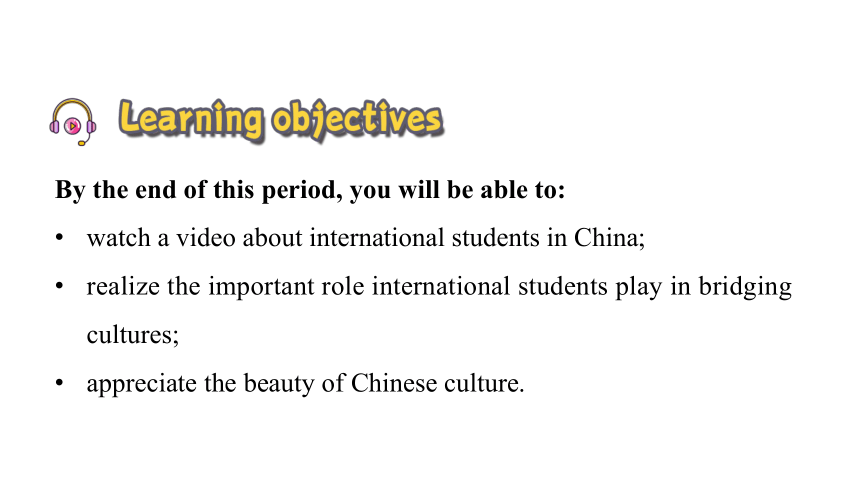

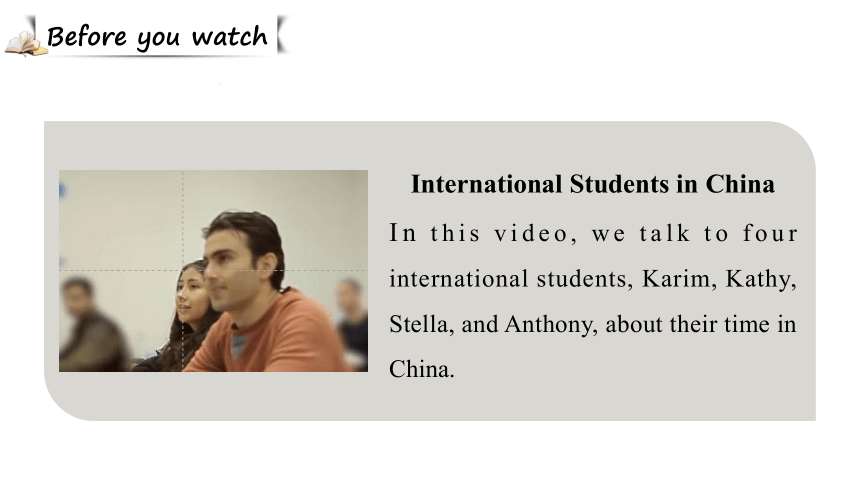
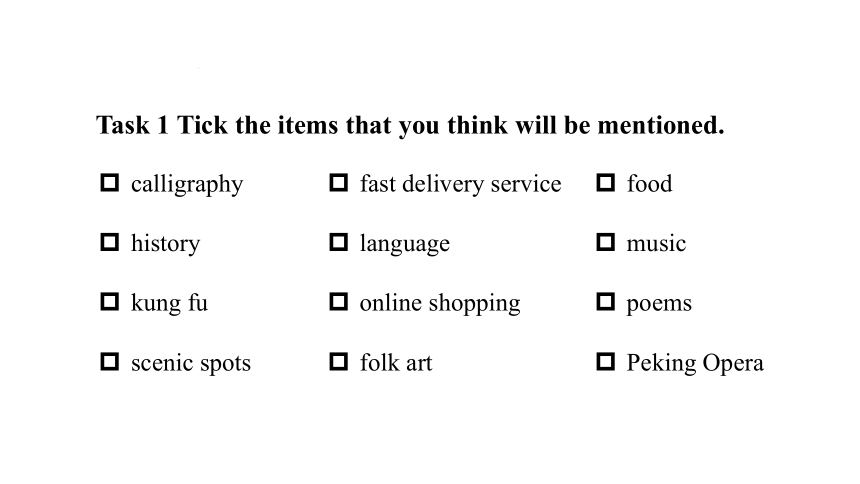


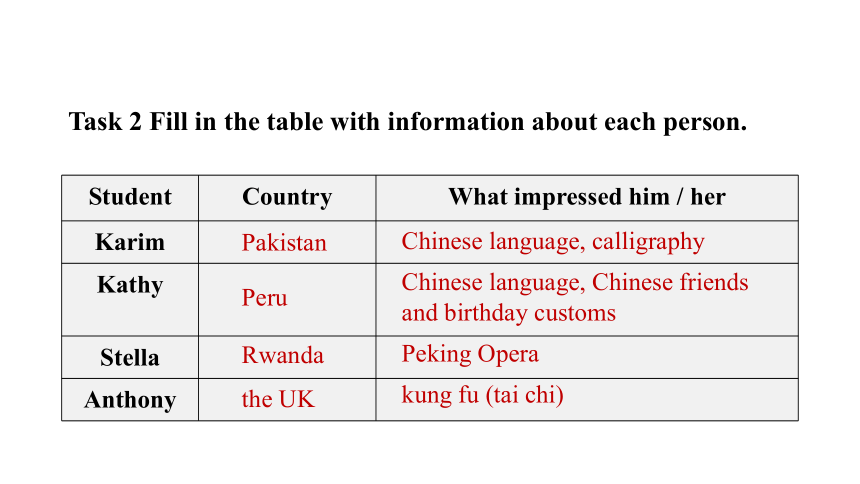
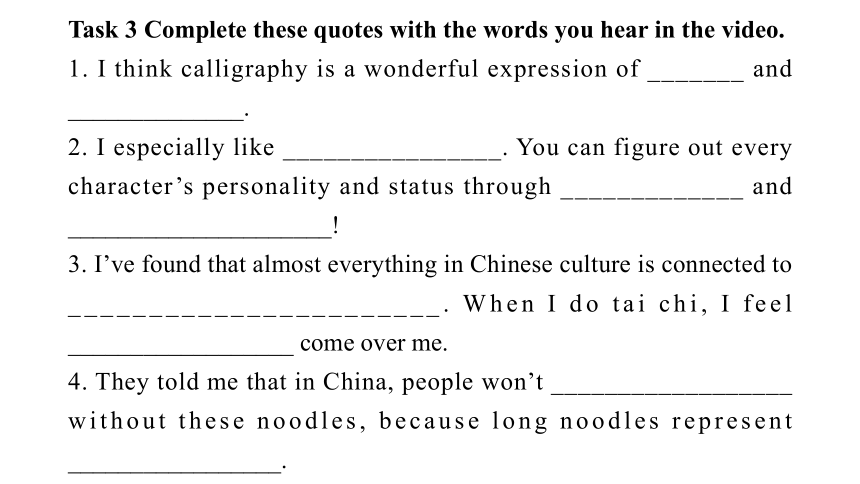
文档简介
(共24张PPT)
Video Time
Unit 2
Bridging cultures
By the end of this period, you will be able to:
watch a video about international students in China;
realize the important role international students play in bridging cultures;
appreciate the beauty of Chinese culture.
Lead-in
What do you think the foreign students in the video enjoy most about China
calligraphy
kung fu
Peking Opera
food
Before you watch
International Students in China
In this video, we talk to four international students, Karim, Kathy, Stella, and Anthony, about their time in China.
Task 1 Tick the items that you think will be mentioned.
calligraphy
fast delivery service
language
music
online shopping
kung fu
poems
scenic spots
history
Peking Opera
folk art
food
While you watch
Check the answers of Task 1.
calligraphy
fast delivery service
language
music
online shopping
kung fu
poems
scenic spots
history
Peking Opera
folk art
food
√
√
√
√
√
Task 2 Fill in the table with information about each person.
Student Country What impressed him / her
Karim
Kathy
Stella
Anthony
Pakistan
Chinese language, calligraphy
Peru
Chinese language, Chinese friends and birthday customs
Rwanda
Peking Opera
the UK
kung fu (tai chi)
Task 3 Complete these quotes with the words you hear in the video.
1. I think calligraphy is a wonderful expression of _______ and ______________.
2. I especially like ________________. You can figure out every character’s personality and status through _____________ and _____________________!
3. I’ve found that almost everything in Chinese culture is connected to _______________________. When I do tai chi, I feel __________________ come over me.
4. They told me that in China, people won’t __________________ without these noodles, because long noodles represent _________________.
1. I think calligraphy is a wonderful expression of _______ and ____________________.
freedom
respect for individuality
2. I especially like ________________. You can figure out every character’s personality and status through _____________ and _____________________!
the facial makeup
the colours
symbols on their faces
3. I’ve found that almost everything in Chinese culture is connected to _______________________. When I do tai chi, I feel __________________ come over me.
the life wisdom of kung fu
a real sense of peace
4. They told me that in China, people won’t __________________ without these noodles, because long noodles represent _________________.
celebrate a birthday
the longevity of life
Read together
Narrator: In recent years, China has become a popular destination for international students. Today we’ll meet a few of the many students from abroad studying in China, and take a quick look at their lives here.
Narrator: The main thing that international students coming to China learn is the language. For many of these curious young people, Chinese is an ancient, mysterious, and very interesting language. Learning Chinese of course helps them with daily communication, but, more importantly, it is a key opening up the treasures of Chinese culture.
Karim: I have enjoyed learning Chinese, but it’s been a challenge. I cannot tell the four tones apart yet. 我问你or我吻你?夫妻or福气 I think I still have a long way to go to become a Chinese teacher!
Kathy: I do think that Chinese characters are quite difficult to write! Some of them look like pictures, such as鱼, 马, 森, so those are fairly easy for me to remember. But others are really difficult to remember, because they are combinations of different parts, like 休, 采. So, I try to learn them by making up a story for myself, to connect the parts of the character to its meaning. Chinese characters are really difficult but I also think that they are so artistic!
Narrator: Some international students are particularly interested in the artistic aspect of Chinese characters. Karim has been practicing calligraphy for several months. He loves the beauty of the art form and says it has given him a better understanding of Chinese culture.
Karim: I think calligraphy is a wonderful expression of freedom and respect for individuality. There are so many different styles. like 楷书,隶书, (and)草书. 柳公权 is my favorite, very elegant. My teacher told me that (the) Chinese believe that writing beautifully is basic etiquette, and many Chinese children learn calligraphy at a very young age. And I hope I can catch up with the Chinese children someday, ha-ha!
Narrator: Many international students share the same passion for Chinese culture. Stella is a big fan of the theatre, and when one of her Chinese friends invited her to a Peking Opera show last summer, she fell in love with it.
Stella: The way of acting, the staging ... are so unusual, so fresh and lovely. I especially like the facial makeup. You can figure out every character’s personality and status through the colours and symbols on their faces! Red stands for loyalty, black for integrity, white for scheming, green for irritability ... It’s such a creative way to present the characters, very expressive.
Narrator: While Stella has been enjoying Peking Opera, Anthony is realising his kung fu dream. Like many boys, he has been a fan of kung fu movies since young. His very first trip within China was to Shaolin Temple. Gradually, Anthony has been learning that there are many different kung fu styles. Some are tough, like Bruce Lee’s style, while others are soft, like tai chi.
Anthony: When I began learning kung fu, I spent nearly two weeks just practicing 坐腿. The first step is always the hardest, but I think I’ve finally got on the right track now. When I do推手, I can feel the heat in my palms. I’ve found that almost everything in Chinese culture is connected to the life wisdom of kung fu. When I do tai chi, I feel a real sense of peace come over me. In Chinese,修身养性. It’s been a truly wonderful experience!
Narrator: In addition to learning the language and the culture, international students have another big gain: friendship. When Kathy first arrived in China, she was anxious about the unknown language and society. However, the hospitality of the people she met quickly made her worries melt away. After a month here, she has found herself adjusting well to the new environment.
Kathy: My first birthday in China was an unforgettable moment for me. I entered the room, and my Chinese friends were there with a cake! I was so touched! They also prepared for me special noodles — these noodles are called长寿面. They told me that in China people won’t celebrate a birthday without these noodles, because long noodles represent the longevity of life. I think it’s a wonderful custom! And those were the most delicious noodles I’ve ever had!
Narrator: As more and mare international students come to China from all over the world, more communication, greater cultural exchange, and a deeper mutual understanding are developing. The connection between China and the world is growing stronger, as their young people forge deep friendships.
After you watch
1. Imagine that your family is hosting an international student. What would you want to share with him / her about China
First of all, I would want to take them to the Great Wall, the Palace Museum, and the Terracotta Warriors Museum. I think these are cultural and historical places that they will be very interested in visiting! Then I would suggest that they try some Chinese food — it is possible they haven’t tried authentic(真正的) Chinese food before. I think they will love Beijing Roast Duck, maybe some fried eggplant, and many, many dumplings. I would also take them to a traditional tea house to experience some local culture — it’s certainly different from a coffee shop they may be used to back in their home country! These are some of the things that I would want to share with them about China.
2. If you had a chance to go overseas as an international student, which country would you go to Why
Answers may vary.
A common language is a bridge between cultures.
一种通用语言是沟通各国文化的桥梁。
Summary
Write an article to introduce Chinese culture to international students.
Homework
Video Time
Unit 2
Bridging cultures
By the end of this period, you will be able to:
watch a video about international students in China;
realize the important role international students play in bridging cultures;
appreciate the beauty of Chinese culture.
Lead-in
What do you think the foreign students in the video enjoy most about China
calligraphy
kung fu
Peking Opera
food
Before you watch
International Students in China
In this video, we talk to four international students, Karim, Kathy, Stella, and Anthony, about their time in China.
Task 1 Tick the items that you think will be mentioned.
calligraphy
fast delivery service
language
music
online shopping
kung fu
poems
scenic spots
history
Peking Opera
folk art
food
While you watch
Check the answers of Task 1.
calligraphy
fast delivery service
language
music
online shopping
kung fu
poems
scenic spots
history
Peking Opera
folk art
food
√
√
√
√
√
Task 2 Fill in the table with information about each person.
Student Country What impressed him / her
Karim
Kathy
Stella
Anthony
Pakistan
Chinese language, calligraphy
Peru
Chinese language, Chinese friends and birthday customs
Rwanda
Peking Opera
the UK
kung fu (tai chi)
Task 3 Complete these quotes with the words you hear in the video.
1. I think calligraphy is a wonderful expression of _______ and ______________.
2. I especially like ________________. You can figure out every character’s personality and status through _____________ and _____________________!
3. I’ve found that almost everything in Chinese culture is connected to _______________________. When I do tai chi, I feel __________________ come over me.
4. They told me that in China, people won’t __________________ without these noodles, because long noodles represent _________________.
1. I think calligraphy is a wonderful expression of _______ and ____________________.
freedom
respect for individuality
2. I especially like ________________. You can figure out every character’s personality and status through _____________ and _____________________!
the facial makeup
the colours
symbols on their faces
3. I’ve found that almost everything in Chinese culture is connected to _______________________. When I do tai chi, I feel __________________ come over me.
the life wisdom of kung fu
a real sense of peace
4. They told me that in China, people won’t __________________ without these noodles, because long noodles represent _________________.
celebrate a birthday
the longevity of life
Read together
Narrator: In recent years, China has become a popular destination for international students. Today we’ll meet a few of the many students from abroad studying in China, and take a quick look at their lives here.
Narrator: The main thing that international students coming to China learn is the language. For many of these curious young people, Chinese is an ancient, mysterious, and very interesting language. Learning Chinese of course helps them with daily communication, but, more importantly, it is a key opening up the treasures of Chinese culture.
Karim: I have enjoyed learning Chinese, but it’s been a challenge. I cannot tell the four tones apart yet. 我问你or我吻你?夫妻or福气 I think I still have a long way to go to become a Chinese teacher!
Kathy: I do think that Chinese characters are quite difficult to write! Some of them look like pictures, such as鱼, 马, 森, so those are fairly easy for me to remember. But others are really difficult to remember, because they are combinations of different parts, like 休, 采. So, I try to learn them by making up a story for myself, to connect the parts of the character to its meaning. Chinese characters are really difficult but I also think that they are so artistic!
Narrator: Some international students are particularly interested in the artistic aspect of Chinese characters. Karim has been practicing calligraphy for several months. He loves the beauty of the art form and says it has given him a better understanding of Chinese culture.
Karim: I think calligraphy is a wonderful expression of freedom and respect for individuality. There are so many different styles. like 楷书,隶书, (and)草书. 柳公权 is my favorite, very elegant. My teacher told me that (the) Chinese believe that writing beautifully is basic etiquette, and many Chinese children learn calligraphy at a very young age. And I hope I can catch up with the Chinese children someday, ha-ha!
Narrator: Many international students share the same passion for Chinese culture. Stella is a big fan of the theatre, and when one of her Chinese friends invited her to a Peking Opera show last summer, she fell in love with it.
Stella: The way of acting, the staging ... are so unusual, so fresh and lovely. I especially like the facial makeup. You can figure out every character’s personality and status through the colours and symbols on their faces! Red stands for loyalty, black for integrity, white for scheming, green for irritability ... It’s such a creative way to present the characters, very expressive.
Narrator: While Stella has been enjoying Peking Opera, Anthony is realising his kung fu dream. Like many boys, he has been a fan of kung fu movies since young. His very first trip within China was to Shaolin Temple. Gradually, Anthony has been learning that there are many different kung fu styles. Some are tough, like Bruce Lee’s style, while others are soft, like tai chi.
Anthony: When I began learning kung fu, I spent nearly two weeks just practicing 坐腿. The first step is always the hardest, but I think I’ve finally got on the right track now. When I do推手, I can feel the heat in my palms. I’ve found that almost everything in Chinese culture is connected to the life wisdom of kung fu. When I do tai chi, I feel a real sense of peace come over me. In Chinese,修身养性. It’s been a truly wonderful experience!
Narrator: In addition to learning the language and the culture, international students have another big gain: friendship. When Kathy first arrived in China, she was anxious about the unknown language and society. However, the hospitality of the people she met quickly made her worries melt away. After a month here, she has found herself adjusting well to the new environment.
Kathy: My first birthday in China was an unforgettable moment for me. I entered the room, and my Chinese friends were there with a cake! I was so touched! They also prepared for me special noodles — these noodles are called长寿面. They told me that in China people won’t celebrate a birthday without these noodles, because long noodles represent the longevity of life. I think it’s a wonderful custom! And those were the most delicious noodles I’ve ever had!
Narrator: As more and mare international students come to China from all over the world, more communication, greater cultural exchange, and a deeper mutual understanding are developing. The connection between China and the world is growing stronger, as their young people forge deep friendships.
After you watch
1. Imagine that your family is hosting an international student. What would you want to share with him / her about China
First of all, I would want to take them to the Great Wall, the Palace Museum, and the Terracotta Warriors Museum. I think these are cultural and historical places that they will be very interested in visiting! Then I would suggest that they try some Chinese food — it is possible they haven’t tried authentic(真正的) Chinese food before. I think they will love Beijing Roast Duck, maybe some fried eggplant, and many, many dumplings. I would also take them to a traditional tea house to experience some local culture — it’s certainly different from a coffee shop they may be used to back in their home country! These are some of the things that I would want to share with them about China.
2. If you had a chance to go overseas as an international student, which country would you go to Why
Answers may vary.
A common language is a bridge between cultures.
一种通用语言是沟通各国文化的桥梁。
Summary
Write an article to introduce Chinese culture to international students.
Homework
